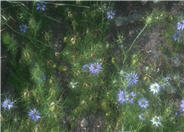
Common name:Hollyhock
Botanical name:Alcea rosea
This plant grows 4-8' high and is particularly useful for background screening. It grows best in full sun in deep, rich, well drained soils and can produce a variety of colors of flowers.

Common name:White Sage, Sacred White Sage, Bee
Botanical name:Salvia apiana
This woody shrub has long stems with silvery white leaves and fragrant white flowers that bloom in the spring. It provides a strong sturctural form as a garden focal point. It can reach 6' tall and 6'wide.

Common name:California or Golden Poppy
Botanical name:Eschscholzia californica
This small annual (sometimes acts as a perennial) plant will grow to less than 1' tall and has light, small blue-green leaves with gold and orange flowers that bloom in spring and summer.

Common name:Asparagus Fern, Fern Asparagus
Botanical name:Asparagus setaceus
This vining plant is distinguished by its wispy foliage, climbing to 10' or more. It is excellent as a container plant, house plant, or in hanging baskets. The fern should be grown in part shade to shade, with average summer watering.
-Monterey Bay Nursery

Common name:Love-In-A-Mist
Botanical name:Nigella damascena
Nigella damascena is an annual. Branching to 1'-1.5' high. All leaves are finely cut into threadlike divisons. Blue, white, or rose flowers, 1"-1.5" across bloom in spring. This beautiful annual was actually used in Elizabethan times for English cottage gardens. It looks great in window boxes and will self-seed.

Common name:Bearded Iris
Botanical name:Iris Bearded Hybrids
This perennial will grow 1'-3' tall and has medium sized, blue green leaves with flowers of different colors that bloom in spring. It needs well draining soil and full sun. Many are fragrant and rebloom several times a year. Plant rhizomes in Sept or Oct. They need water once a week during the hot spells. Top dress with compost and gypsum in January and August.
More than half of the water used at your home is for outside purposes. Studies show that on average, half of the water used outdoors is wasted. The leading cause of waste is incorrectly set and poorly managed irrigation controllers. The second biggest cause of wastage is broken irrigation equipment that goes undetected. There are a few basic things you can do to make a big difference in your water use.
Click in the green box for more information
Designer: Terri Nichols
Photographer: GardenSoft
Physical weed control, including mulching, or hand removal protects the watershed from harmful chemicals.
Develop healthy soil for plants that are vigorous and naturally pest-resistant.